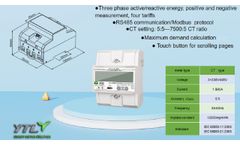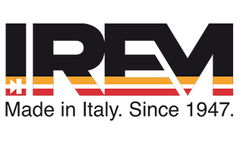Power Quality Conditioner Articles & Analysis
16 articles found
The total power, peak power, valley power, peak power unit price, and valley power unit price of the day can be intuitively felt by experiencing the benefits brought about by installing a tariff power meter. ...
The Power Quality problems of an electrical distribution network are often generated locally within the structures and can depend on various situations, such as, for example, construction works, switching on high loads, faulty distribution components and particular basic electrical disturbances. Furthermore, external causes such as atmospheric events (hurricanes, lightning, snow, ice and ...
With the increasingly widespread use of sensitive electrical and electronic equipment, it is essential to have a “clean” and stable mains power supply to protect and make critical applications reliable. IREM Steroguard Line Conditioners represent the solution for most of the disturbances coming from the electrical network: they offer ...
The success of this system is not only providing an improved quality of power compared to the electricity networks volatile voltage supply, but it also offers 15% payback per year viable financial investment. In certain seasons the cattle station can experience up to 20 power cuts per day and can be without power for weeks at a ...
An adaptive hysteresis current and voltage control technique for controlling Unified Power Quality Conditioner (UPQC) is proposed in this paper. The novelty of the proposed method is the series and shunt active power filters (APF) present in the UPQC has been controlled by the separate adaptive controllers for reducing the ...
This means the unit can produce the amount of inrush current that many power hungry appliances and tools need to operate, such as air conditioners and power tools. ...
Net metering is a concept that has been talked about extensively in the world of solar. But, what exactly does it mean for you and when will it come to ...
This paper presents a three-phase shunt active power line conditioner (APLC) for harmonics and reactive power compensation to enhance the power quality. The compensation process is based on sinusoidal extraction control method, which consists of positive-sequence voltage detector to regulate the distorted supply ...
Unified power quality conditioner (UPQC) is a combination of series and shunt active power filters with a common DC link. This device is used to enhance power quality by injecting required amount of Volt–Ampere (VA) into the system. ...
This paper presents an innovative implementation of the recursive Gauss-Newton (GN) algorithm for extraction of the common current quality problems such as the current harmonics and current fluctuation. ...
As these sources are intermittent in nature, they impose technical challenges in the power system operation which include power quality related problems of local grid. ...
In recent years unified power quality conditioner (UPQC) is being used as a universal active power conditioning device to mitigate both current as well as voltage harmonics at a distribution end of power system network. ...
It discusses the penetration of DGs and addresses RES availability, conversion technologies and quality control of DG systems.Keywords: distributed generation, renewable energy sources, RES, voltage stabilisation, power quality ...
Active power supply is mainly dependent on the potential of wind power produced and the turbine design. ...
Improving power quality for sensitive load by a Unified Power Quality Conditioner (UPQC) in a distributed generation system is presented in this paper. The power balance of a UPQC, consisting of back-to-back connected series and shunt Active Filters (AF), is analysed. ...
In this paper, modelling and simulation of a grid connected variable speed wind energy conversion system (VSWECS) with reduced switch count power converter is presented. The system consists of a permanent magnet synchronous generator (PMSG), two pulse width modulated B-4 power converters and a maximum power point tracker (MPPT). Mathematical models of each element of the system are developed ...





